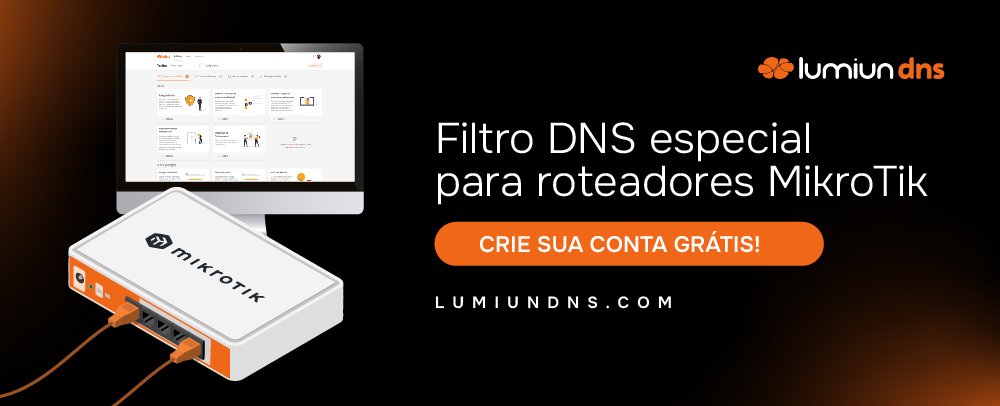Continuing the previous article , we hope that the need and purpose of identifying data leaks in companies .
A requirement, when the intention is to prevent and avoid losses resulting from this type of security incident .
A challenge for managing internet access and information security in small and medium-sized companies.
Therefore, monitoring risks and controlling the human factor on the corporate internet are the recommended strategy and practice for you to identify data leaks in your company .
This way, business owners, IT professionals and managers are able to combat improper access, unauthorized collection and public exposure of data .
After all, prevention is the best medicine. Mainly when it comes to data leaks in companies.
Therefore, information is essential to minimize the impact of the human factor and the main risks, security breaches, vulnerabilities and situations in which data protection is threatened.
See how to prevent data leaks
Watch the video from the Olhar Digital with an overview of digital security, information security incidents and data leaks .
In “Data leaks: learn how to protect yourself” (6:56), in a very didactic way, see how public and corporate environments have vulnerabilities that can be exploited by virtual criminals .
It is curious to realize that most people neglect to take care of their own information and end up exposing it in the virtual environment, spontaneously.
Finally, outside the personal sphere, this behavior is reproduced in the corporate environment . This compromises data security and can penalize companies .
Therefore, there is little care and all information is welcome.
Likewise, it doesn't hurt to reinforce the usefulness of Web access policies , information security management and compliance processes . After all, they allow you to prevent and identify data leaks in companies.
Data leaks are the responsibility of company management
The video confirms what we have already written: most data leaks occur due to carelessness when accessing the internet and sharing personal data .
Lack of care and negligence when accessing the internet causes a series of inconveniences and losses for individuals.
When this behavior is reproduced at the corporate level , the risks are even greater and the consequences can lead to major losses.
It is important to highlight that companies must establish and enforce internet access and data security policies for their employees.
After all, it is the responsibility of business management to curb, control and monitor employees' risky behaviors .
By allowing inappropriate and/or inappropriate employee behavior, it exposes vulnerabilities and security holes . Above all, because:
- Every company is exposed to data leaks.
- Without prevention and control, any employee can put your company at risk.
- Without compliance processes against data leakage (technology, tools and control), companies become negligent.
It is the legal obligation of managers and companies to preserve integrity, data privacy and digital security. To do this, they must use efficient solutions and technologies available on the market .
20 recommendations to prevent data leaks and digital threats
We have prepared a list of 20 security recommendations to identify data leaks in companies and other digital threats.
These are general and appropriate recommendations for companies of any industry and size to protect data (yours and under your responsibility):
- Pay more attention, control access and unknown, unwanted, inappropriate or harmful websites
- Deactivate unused digital accounts.
- Avoid using simple and repeated passwords.
- Use two-factor authentication.
- Prevent or control the saving of files and data locally on computers and mobile devices without backup.
- Institute DNS Firewall .
- Provide remote access to the company's internal systems and resources using a VPN .
- Limit the publication of data and information about the company during working hours.
- Create an internet access and data security management policy.
- Establish a contingency and damage reduction plan in case there is a data leak in the company or another type of security incident.
- Invest in backups and encryption of files and sensitive data that need to be in the cloud.
- Report any data leak or any other security incident National Data Protection Authority (ANPD)
- Do not provide or confirm data over the phone, or insecure applications (WhatsApp, Telegram, Signal, among others).
- Register your company in alert services, such as Serasa and the Central Bank, Registrato .
- Automate compliance processes against company data leaks and other security incidents.
- Monitor risk in your suppliers and partners.
- Make employees aware of the need to prevent, protect and identify data leaks and other security incidents.
- Keep the company and compliance processes in data security management always up to date.
Identify data leaks: gaps, vulnerabilities and main risks
The purpose of this article is to facilitate access to information . Therefore, we reproduce excerpts about origins, reasons, main risks, security breaches, vulnerabilities and situations in which data protection in companies is threatened.
The sources of research and consultation are diverse. Therefore, at the end of each block, a “learn more” with a link directed to the original content.
Data leak sources
Data leaks in companies can originate from data theft by attackers and malicious codes that exploit vulnerabilities in systems. With access to user accounts through weak or leaked passwords. Action by employees or former employees who collect information from the company's systems and pass it on to third parties. Theft of equipment containing confidential data. Errors or negligence by employees , such as discarding media (disks and pen drives) without due care.
Main causes of data leakage
The occurrences that most frequently lead to data leaks are:
- Identity theft and hacking of digital accounts.
- Identity theft leading to financial losses.
- Privacy violation.
- Coup attempts.
Who to turn to
If you notice data leaks and fraud, contact the institutions involved and follow the instructions received. Register a Police Report with the police authority, to facilitate the investigation and protect yourself. If you do not know which institution is involved, you can make a report on the National Data Protection Authority (ANPD) .
Do not encourage data leaks and abuse
Don't buy lists of data. This practice encourages more leaks to occur and puts everyone at risk. Avoid accessing websites and opening files that confirm or display leaked information. They may have been created for malicious purposes to further expose your data.
Amount of data it owns and produces
Registration, biographical, professional, financial and navigation data. These are just a few examples of circulation across different networks and storage on different systems, devices and media. There are situations in which information is lost, or improperly accessed and even collected and sold without you being aware of it. Some examples of these situations: losing your cell phone, computer or removable media. Interception during network traffic. A data leak. In the case of hacking of accounts and systems where they are stored. Gather browsing information without transparency and share it without consent.
Information to guarantee rights and obligations
The LGPD exists so that individuals have control over their personal data and know how they are treated by public, private organizations and third parties. According to the Law, personal data is information related to the identified or identifiable natural person. As a data subject, you have several rights guaranteed by the LGPD, in its article 18 .
DDoS Attack
This type of attack overloads server activities, causes system slowdowns and leaves websites and accesses unavailable. A DDoS attack is one of the biggest threats to the full functioning of systems. Thus, it can generate undue access and, in this way, expose companies to other cyberattacks and data leaks.
Port Scanning Attack
If there is a vulnerability in the company's system, this malware searches and finds this weakness on the server. Thus, it takes advantage of the security breach to steal information and data in order to damage the system, kidnap data ( ransomware ) or commit data leaks.
Ransomware
“Data hijacking” blocks access to server files and only releases them upon payment . Cybercriminals determine the value of the “ransom”. They require an amount that must be paid in virtual currency (cryptocurrencies) to avoid tracking. The security vulnerability that starts with improper access, goes through encryption and can lead to data loss or leakage.
Trojan Horse
Malware that only works with the user’s “authorization”. The camouflaged virus is installed on companies' systems when employees execute unknown email attachments or make suspicious downloads. Among the objectives of a Trojan Horse are to interrupt functions, steal information and leak personal data. The Computerworld portal listed some of the biggest Trojan horse viruses in history.
Brute force attacks
This type of malicious attack steals accounts through several attempts at username and password combinations in a very short time. When criminals access and take possession of information, they can send several messages with a sender known to employees, with content such as phishing and spam. Or, requesting deposits, transfers, access passwords and many other sensitive information. A risk to digital security that can lead to data leaks in companies.
Phishing
Generally carried out via email, phishing is a virtual threat that leads employees to reveal confidential information, including passwords, bank details and CPF. As a rule, this type of malicious attack leads contributors to pages identical to the real ones. Like the bank where the company moves its money, for example. Hackers launch a “bait” to trick employees and “fish” for data. It is one of the most common and most successful . A good example of the need to identify data leaks in companies.
Cryptojacking
Computers or any other device connected to the internet start mining cryptocurrencies without companies and users knowing. Typically, the attack is discovered when the slowness of browsing and device performance is really noticeable. Another weakness that leads to data leaks in companies.
ZeroDay
An attack that acts based on flaws and vulnerabilities in newly released software and applications. Explore loopholes and bugs. Less common, it affects more companies that work with development in the digital environment. That's why it's always a good idea to always keep systems, software and applications up to date. A way to minimize threats and risks. It is one of the easiest security situations and vulnerabilities to control. This makes life easier for managers and IT professionals when it comes to preventing digital threats and identifying data leaks in the company.
Spoofing
It translates as “prank” and is very similar to phishing. It occurs when the scammer pretends to be the legitimate user holding the information and tries to access the victim's accounts, servers, make purchases or steal identities. This is what happens in cases of SIM swap.
SIM swap
When a phone number is transferred to another blank SIM card, the cybercriminal calls the operator and pretends to be the victim. Claims to have lost access to the previous chip and requests an exchange. During the call, confirm the data to authenticate your identity and carry out the transfer. It can also occur within the operator itself.
Brushing scam
These are false sales made via the internet. A store creates a fake profile with real data from a consumer (name and address). Then, send any object to the supposed customer (to validate delivery). Then, give a positive evaluation of the purchase. Other legitimate customers are fooled by the fake reviews into purchasing from the site.
The main benefits of prevention
Prevention and information are keywords for you to identify data leaks. Also, to avoid financial losses and protect your company’s reputation.
In this sense, business owners, managers and IT professionals must always be well-informed and prepared to act preventively.
Or, to reduce damages and losses , in the event that no data leaks are identified in the company.
Management measures that do not need to be difficult or complex. After all, there are simple and affordable solutions available on the market .
Preventing information security incidents is the cheapest and smartest strategy.
Furthermore, it enhances compliance processes against data leaks in companies .
At the same time, it makes it difficult for hackers and cyberattacks to occur and causes the destruction, loss or inadequate processing of data.
Thus, it makes protocols, controls and the internet access and information security management policy .
As a result, your company will act in accordance with legislation ( LGPD ). This is essential to protect it against the heavy fines provided for by law. And, also, to preserve the privacy rights and personal data security of users/consumers/citizens .
In practice, in addition to prevention , the best solutions on the market productivity and profitability indicators .
Subscribe to our newsletter and receive more news and materials.











